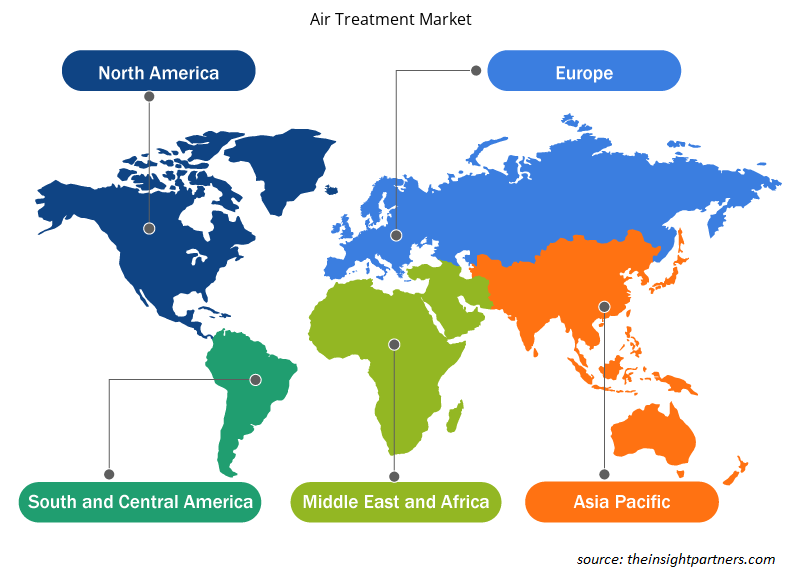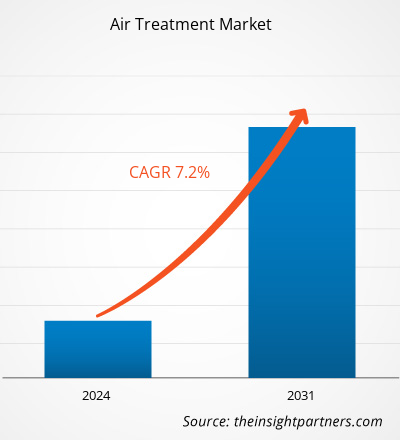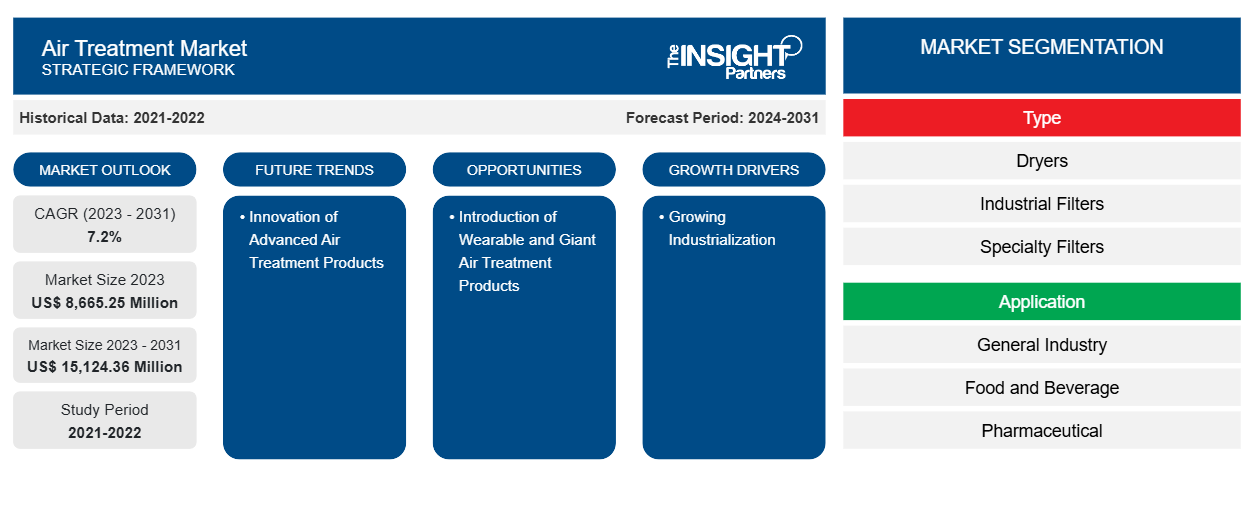Se proyecta que el tamaño del mercado de tratamiento del aire alcance los 15.124,36 millones de dólares estadounidenses en 2031, frente a los 8.665,25 millones de dólares estadounidenses en 2023. Se espera que el mercado registre una CAGR del 7,2 % durante el período 2023-2031. Es probable que la innovación de productos avanzados de tratamiento del aire siga siendo una tendencia clave en el mercado.
Análisis del mercado de tratamiento del aire
Los principales usuarios finales del mercado de tratamiento del aire incluyen los sectores de energía, alimentos y bebidas y petroquímico. Se prevé que en los próximos años el crecimiento urbano se produzca en barrios marginales y otras zonas de construcción informal de los estados y países. Además, las condiciones favorables de crecimiento a nivel mundial y los crecientes proyectos de infraestructura han impulsado la tasa de crecimiento del mercado de tratamiento del aire a nivel mundial.
Descripción general del mercado de tratamiento del aire
Los principales actores en el ecosistema del mercado global de tratamiento del aire incluyen proveedores de hardware/componentes, fabricantes/proveedores de tratamiento del aire y usuarios finales. Los proveedores de componentes/hardware proporcionan diversos componentes/partes/materias primas a los fabricantes de tratamiento del aire para la fabricación del producto final. Se utilizan diferentes tipos de materias primas para fabricar productos de tratamiento del aire. Algunos de los principales fabricantes del mercado en el mercado global de tratamiento del aire incluyen ABIONIK Group GmbH, Beko Technologies, Donaldson Company, Inc., Condorchem Envitech, Parker Hannifin, Kaesar Kompressoren, Mikropor, Odatech Pty Ltd., SPX FLOW, Inc. y Xebec Adsorption Inc, entre muchos otros.
Personalice este informe según sus necesidades
Obtendrá personalización en cualquier informe, sin cargo, incluidas partes de este informe o análisis a nivel de país, paquete de datos de Excel, así como también grandes ofertas y descuentos para empresas emergentes y universidades.
-
Obtenga las principales tendencias clave del mercado de este informe.Esta muestra GRATUITA incluirá análisis de datos, desde tendencias del mercado hasta estimaciones y pronósticos.
Factores impulsores y oportunidades del mercado del tratamiento del aire
Creciente industrialización para favorecer el mercado
La industria del tratamiento del aire está impulsada directa o indirectamente por las vigorosas medidas gubernamentales de apoyo al sector industrial, como las adoptadas por importantes regiones como América del Norte y Europa, a través de diversos foros. Las políticas en Europa son beneficiosas para el desarrollo del negocio, que es una de las razones detrás del crecimiento de la industria electrónica y las PYME en Europa. La formación de la región de la UE ha facilitado los negocios, la importación y la exportación entre los miembros de la unión. Estas industrias son muy comunes en esta región. Por lo tanto, el creciente desarrollo del sector industrial está impulsando la demanda del mercado de tratamiento del aire a nivel mundial.
Presentación de productos gigantes y portátiles para el tratamiento del aire
Los sistemas de filtración de aire se instalan para garantizar la seguridad en los lugares de trabajo industriales. La creciente tendencia de los sistemas de tratamiento de aire ayuda a capturar las partículas de humo más pequeñas en las áreas industriales. La fabricación avanzada de metales aprovechó la tecnología avanzada y los procesos de automatización para producir productos que liberan procesos de calentamiento, gases nocivos y humos como subproducto de la soldadura. Esto ha impulsado la instalación de sistemas colectores de polvo con cartuchos de filtración de alta calidad. La creciente aparición de productos de tratamiento de aire portátiles y gigantes en el sector industrial es uno de los principales proveedores de oportunidades de crecimiento para el mercado en los próximos años.
Análisis de segmentación del informe de mercado de tratamiento del aire
Los segmentos clave que contribuyeron a la derivación del análisis del mercado de tratamiento de aire son el tipo y la aplicación.
- Según el tipo, el mercado de tratamiento de aire se divide en secadores, filtros industriales, filtros especiales y gestión de condensados. El segmento de filtros industriales tuvo una mayor participación de mercado en 2023.
- Por aplicación, el mercado se segmenta en industria general, alimentos y bebidas, farmacéutica, petróleo y gas, química y petroquímica , y minería. El segmento farmacéutico tuvo una participación significativa del mercado en 2023.
Análisis de la cuota de mercado de tratamiento del aire por geografía
El alcance geográfico del informe de mercado de Tratamiento de aire se divide principalmente en cinco regiones: América del Norte, Asia Pacífico, Europa, Medio Oriente y África, y América del Sur y Central.
América del Norte lidera el mercado. La población de los EE. UU. tiene un nivel de vida elevado y la capacidad de gasto de las personas también es inmensa debido al alto ingreso per cápita del país. Esto da como resultado el uso de más instalaciones y aumenta el consumo de recursos en la región. Esto dará como resultado una mayor necesidad de aire fresco en el país, lo que influirá en el crecimiento del mercado de tratamiento del aire. América del Norte es una región tecnológicamente avanzada. Los purificadores de aire inteligentes han sido objeto de una gran adopción en esta región. Estas tecnologías, cuando se integran con máquinas, brindan eficiencias a los usuarios finales. Más implementaciones requieren más competencia en la región junto con el crecimiento de toda la industria que conduce al desarrollo del mercado y las innovaciones.
Perspectivas regionales del mercado de tratamiento del aire
Los analistas de Insight Partners explicaron en detalle las tendencias y los factores regionales que influyen en el mercado de tratamiento del aire durante el período de pronóstico. Esta sección también analiza los segmentos y la geografía del mercado de tratamiento del aire en América del Norte, Europa, Asia Pacífico, Oriente Medio y África, y América del Sur y Central.

- Obtenga los datos regionales específicos para el mercado de tratamiento del aire
Alcance del informe sobre el mercado de tratamiento del aire
| Atributo del informe | Detalles |
|---|---|
| Tamaño del mercado en 2023 | US$ 8.665,25 millones |
| Tamaño del mercado en 2031 | US$ 15.124,36 millones |
| CAGR global (2023 - 2031) | 7,2% |
| Datos históricos | 2021-2022 |
| Período de pronóstico | 2024-2031 |
| Segmentos cubiertos |
Por tipo
|
| Regiones y países cubiertos |
América del norte
|
| Líderes del mercado y perfiles de empresas clave |
|
Densidad de actores del mercado: comprensión de su impacto en la dinámica empresarial
El mercado de tratamiento del aire está creciendo rápidamente, impulsado por la creciente demanda de los usuarios finales debido a factores como la evolución de las preferencias de los consumidores, los avances tecnológicos y una mayor conciencia de los beneficios del producto. A medida que aumenta la demanda, las empresas amplían sus ofertas, innovan para satisfacer las necesidades de los consumidores y aprovechan las tendencias emergentes, lo que impulsa aún más el crecimiento del mercado.
La densidad de actores del mercado se refiere a la distribución de las empresas o firmas que operan dentro de un mercado o industria en particular. Indica cuántos competidores (actores del mercado) están presentes en un espacio de mercado determinado en relación con su tamaño o valor total de mercado.
Las principales empresas que operan en el mercado de tratamiento de aire son:
- Tecnologías Beko
- Compañía Donaldson, Inc.
- Parker Hannifin
- Honeywell Internacional Inc.
- Planta de depuración de Hongrijia Science-Technology Co., Ltd.
- Compañía: Ingersoll Rand Inc.
Descargo de responsabilidad : Las empresas enumeradas anteriormente no están clasificadas en ningún orden particular.

- Obtenga una descripción general de los principales actores clave del mercado de tratamiento del aire
Noticias y desarrollos recientes del mercado de tratamiento del aire
El mercado de tratamiento del aire se evalúa mediante la recopilación de datos cualitativos y cuantitativos posteriores a la investigación primaria y secundaria, que incluye publicaciones corporativas importantes, datos de asociaciones y bases de datos. A continuación, se enumeran algunos de los desarrollos en el mercado de tratamiento del aire:
- Ingersoll Rand Inc., un proveedor global de soluciones industriales y de creación de flujo de misión crítica, cerró la adquisición de Friulair Srl (“Friulair”) por un precio de compra inicial en efectivo de aproximadamente US$ 146 millones. (Fuente: Ingersoll Rand Inc, comunicado de prensa, febrero de 2024)
- Honeywell International Inc. lanzó su monitor de calidad del aire interior (IAQ), que alerta a los propietarios y operadores de edificios sobre posibles problemas para mejorar de forma proactiva la calidad del aire interior, lo que podría reducir el riesgo de transmisión de contaminantes aéreos. (Fuente: Honeywell International Inc., comunicado de prensa, febrero de 2022)
Informe sobre el mercado de tratamiento del aire: cobertura y resultados
El informe “Tamaño y pronóstico del mercado de tratamiento del aire (2021-2031)” proporciona un análisis detallado del mercado que cubre las siguientes áreas:
- Tamaño del mercado de tratamiento del aire y pronóstico a nivel mundial, regional y nacional para todos los segmentos clave del mercado cubiertos bajo el alcance
- Tendencias del mercado de tratamiento del aire, así como dinámicas del mercado, como impulsores, restricciones y oportunidades clave
- Análisis PEST y FODA detallados
- Análisis del mercado de tratamiento del aire que cubre las tendencias clave del mercado, el marco global y regional, los principales actores, las regulaciones y los desarrollos recientes del mercado.
- Análisis del panorama de la industria y de la competencia que abarca la concentración del mercado, el análisis de mapas de calor, los actores destacados y los desarrollos recientes del mercado de tratamiento del aire.
- Perfiles detallados de empresas
- Análisis histórico (2 años), año base, pronóstico (7 años) con CAGR
- Análisis PEST y FODA
- Tamaño del mercado, valor/volumen: global, regional y nacional
- Industria y panorama competitivo
- Conjunto de datos de Excel
Informes recientes
Testimonios
Razón para comprar
- Toma de decisiones informada
- Comprensión de la dinámica del mercado
- Análisis competitivo
- Información sobre clientes
- Pronósticos del mercado
- Mitigación de riesgos
- Planificación estratégica
- Justificación de la inversión
- Identificación de mercados emergentes
- Mejora de las estrategias de marketing
- Impulso de la eficiencia operativa
- Alineación con las tendencias regulatorias























 Obtenga una muestra gratuita para - Mercado de tratamiento del aire
Obtenga una muestra gratuita para - Mercado de tratamiento del aire